County of Bute
The County of Bute (Scottish Gaelic: Siorrachd Bhòid), also known as Buteshire,[1] is a historic county and registration county of Scotland.[2]
Bute | |
|---|---|
 | |
| Country | Scotland |
| County town | Rothesay |
| Area | |
| • Total | 225 sq mi (583 km2) |
| Ranked 30th of 34 | |
| Chapman code | BUT |
The county comprises a number of islands in the Firth of Clyde, between the counties of Argyll and Ayrshire, the principal islands being Bute, Arran, Great Cumbrae and Little Cumbrae. The county town is Rothesay, located on the Isle of Bute. Buteshire had its own elected county council from 1890 to 1975.
Local government councils
Buteshire had its own elected local government council from 1890 to 1975. However, in 1975 this system was superseded and Buteshire was divided for administrative purposes between the Strathclyde region districts of Argyll and Bute (which administered the Isle of Bute) and Cunninghame (which administered Arran and the Cumbraes). The Scottish regions were abolished in 1996, and this divide of the historic county continued, with both districts which administered historic Buteshire becoming council areas (Cunninghame under the name "North Ayrshire").
Geography
Buteshire consists of two main islands in the Firth of Clyde separated by the Sound of Bute - Arran (also including the much smaller Holy Island, Hamilton Isle and Pladda off the south-east coast) and Bute (including the small isle of Inchmarnock off its west coast) - and also the Cumbraes between Bute and Ayrshire on the mainland, comprising Great Cumbrae, Little Cumbrae and the islets of The Eileans, Broad Islands, Castle Island and Trail Island.
Arran is Scotland's 7th largest island and is a popular tourist destination, often referred to as 'Scotland in miniature' due to the wide variety of scenery and geographical features that can be found here. The island is roughly peanut-shaped, being flatter in the south and more mountainous in the north, culminating in Goat Fell, the tallest mountain in Buteshire at 874 metres (2,866 ft). It is separated from the Kintyre peninsula by Kilbrannan Sound. Bute is in contrast is a much flatter though somewhat hilly island, especially in the north; it is separated from the Cowal peninsula by the narrow Kyles of Bute. A number of lochs lie in the centre of the island, most notably Loch Fad, Loch Quien and Loch Ascog.
Transport
Bute is connected by ferry to Wemyss Bay on the mainland; a ferry also connects the island with the Cowal peninsula from the north-east of the island. An A-road runs along Bute's east coast and loops around the island's southern half; the northern half of the island is less well-served and can mostly only by traversed by foot or bike. Arran is also connected to the Scottish mainland by ferry; from the north one can reach Tarbet and Claonaig in Kintyre, and from Rothesay ferries depart for Ardrossan in Ayrshire and Campbeltown further down the Kintyre peninsula. A road goes around the edge of the island, with a B road cutting east-west across. A ferry also connects Great Cumbrae with Largs in Ayrshire.

Parliamentary constituency
There was a Buteshire constituency of the House of Commons of the Parliament of Great Britain from 1708 to 1800 and of the Parliament of the United Kingdom from 1801 to 1918. Between 1708 and 1832 it was an alternating constituency with Caithness: one constituency elected a Member of Parliament (MP) to one parliament then the other elected an MP to the next. Between 1832 and 1918 it was a separate constituency, electing an MP to every parliament.
The population of Buteshire in 1841 was 15,740.[3]
In 1918 the constituency was combined with the Ayrshire North constituency to form the Bute and Northern Ayrshire constituency, a constituency which straddled the boundary between the local government counties of Bute and Ayrshire.
In 1983, eight years after Scottish local government counties had been abolished, the Bute and Northern Ayrshire constituency was divided between the Argyll and Bute constituency and the Cunninghame North constituency.
In 2005, both constituencies were enlarged as part of the Fifth Periodic Review of Westminster constituencies.[4] The name "Argyll and Bute" was retained, while the enlarged Cunningham North was named North Ayrshire and Arran.
Constituencies with similar boundaries to the pre-2005 constituencies, and also called Argyll and Bute and Cunninghame North, are used by the Scottish Parliament.
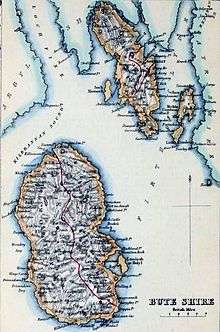
Civil parishes
- North Bute
- Rothesay
- Kingarth
- Cumbraes or Great Cumbrae
- Kilbride, Arran
- Kilmory, Arran
- Lochranza
Gallery
- Rothesay Castle, Bute with the 16th century forework in the centre, and the 13th century "Pigeon Tower" on the right
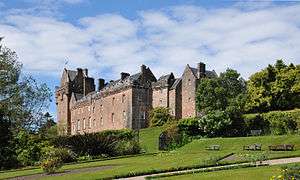 Brodick Castle, Arran
Brodick Castle, Arran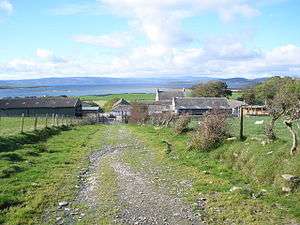 Kilmory Castle is incorporated into Meikle Kilmory Farm, Bute
Kilmory Castle is incorporated into Meikle Kilmory Farm, Bute Machrie Moor Stone Circle, Arran
Machrie Moor Stone Circle, Arran Isle of Arran
Isle of Arran Blaeu Atlas. Arania
Blaeu Atlas. Arania Blaeu Atlas. Buthe Insula
Blaeu Atlas. Buthe Insula Shire of Bute. by H. Moll
Shire of Bute. by H. Moll Kerrycroy Bay, Bute
Kerrycroy Bay, Bute Ardbeg, Bute
Ardbeg, Bute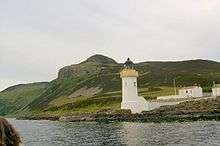 Lighthouse on Holy Island
Lighthouse on Holy Island- The isle of Pladda as seen from Arran, with Ailsa Craig in the distance
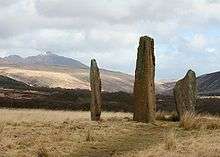 Machrie Moor Standing Stones on Arran
Machrie Moor Standing Stones on Arran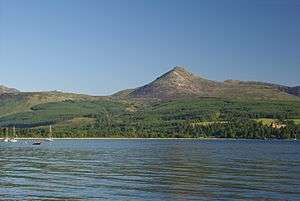 Goat Fell on Arran, the highest point of Buteshire
Goat Fell on Arran, the highest point of Buteshire
References
- Chisholm, Hugh, ed. (1911), , Encyclopædia Britannica, 4 (11th ed.), Cambridge University Press, p. 879
- "Land Register Counties", Leaflets, Registers of Scotland, archived from the original on 2 February 2010
- The National Cyclopaedia of Useful Knowledge, Vol.III, London, Charles Knight, 1847, p.967
- "The Parliamentary Constituencies (Scotland) Order 2005", legislation.gov.uk, The National Archives, SI 2005/250
- "County Bute: List of towns and places", Registers of Scotland, Land Register, 2000, archived from the original on 6 October 2002
External links

- NLS map of Buteshire. John Thompson's Atlas of Scotland. 1832.
| Wikimedia Commons has media related to Buteshire. |
| Wikimedia Commons has media related to Towns and villages in Argyll and Bute. |
| Wikimedia Commons has media related to Great Cumbrae. |
| Wikimedia Commons has media related to Isle of Arran. |
| Wikisource has the text of the 1911 Encyclopædia Britannica article Bute (county). |